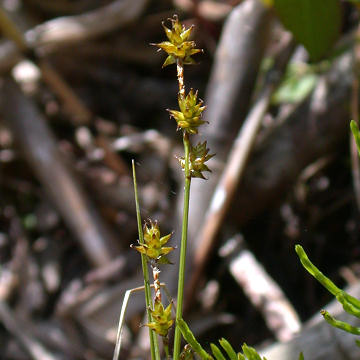

Carex atlantica - (image 1 of 6)
Taxonomy
Family: Cyperaceae
Section Stellulatae (Star Sedges)
cespitose habit, gynaecandrous spikes
perigynia planoconvex to biconvex in section with spongy bases, spreading to reflexed, the beak bidentate
Habitat
Bogs, swamps, moist acid sands.
Associates
Distribution
Nova Scotia south to FL, west to MI, IL, MO, AR, and TX.
Morphology
Plants monoecious, growing in dense tufts (cespitose); spikes 3-6, sessile, lateral spikes pistillate, terminal spike gynaecandrous (with staminate flowers below the pistillate); perigynia longer than wide, to 3.8 mm long, brown at maturity, several-nerved, more or less cuneate to concavely tapered to the sparsely serrulate, sharply bidentate beak; stigmas 2; achene lenticular.
Notes
Fruiting May to July
Wetland indicator: OBL
The typical form, shown here, has leaves more than 1.6 mm wide and inflorescences mostly more than 2 cm long. The variety capillacea (L.H. Baily) Cronquist is smaller, more slender and is confined mostly to the coastal plain.
References
Frye, Christopher T. and Lea, C. 2005. Field, Taxonomic, and Nomenclatural Notes on Carex, Section Stellulatae (Cyperaceae) in Delaware, Maryland, the District of Columbia, and West Virginia. Northeastern Naturalist, 12(3) 361-373.
Gleason, Henry A. and A. Cronquist. 1991. Manual of Vascular Plants of
Northeastern United States and Adjacent Canada. Second Ed.
The New York Botanical Garden. Bronx, NY
Swink, F. and G. Wilhelm. 1994. Plants of the Chicago Region.
Indiana Academy of Science. The Morton Arboretum. Lisle, Illinois.
|
© Michael Hough 2010 |